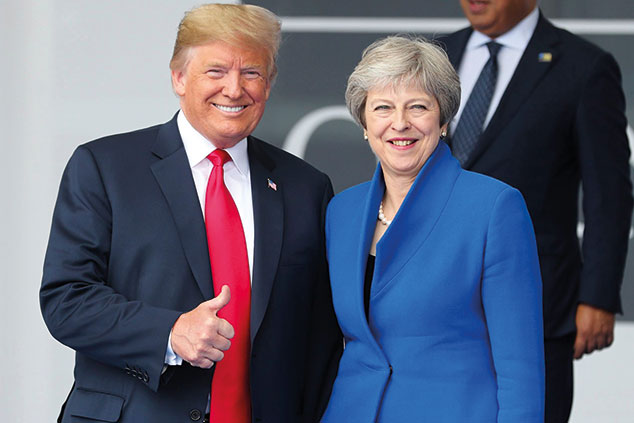
Nerves are jangling ahead of the Nato summit and a meeting with Putin. Emily Hohler reports.
There are fears of a “possible two-headed diplomatic assault from Trump” this week as he attends a summit of Nato leaders in Brussels and concludes his European tour with a one-to-one meeting with the Russian president, Vladimir Putin, says Michael Birnbaum in The Washington Post. At the Nato summit (and amid simmering disputes with the EU over trade) Trump is expected to continue to lambast Europeans for “slacking” on their defence spending. European leaders worry that he could “bargain away their security in the name of better relations with the Kremlin”.
Although few believe that Trump will withdraw from Nato, they fear he could “initiate an unravelling” by undermining it. For example, by taking US troops out of military exercises in eastern Europe to avoid “provoking” Putin (he made a similar unilateral concession during his meeting with North Korea’s Kim Jong-un), by reducing the US military presence in Europe, or by recognising Russia’s annexation of Crimea.
Trump’s unpredictability problem
Of course, that’s not the line from US officials. On paper, at least, Trump is set to condemn Russian behaviour in Ukraine, endorse collective defence and “sign off on a range of new plans that would expand US military activity in Europe, not diminish it”. The US ambassador to Nato, Kay Bailey Hutchison, says the “overall theme” of the summit is “strength and unity”.
There’s plenty to celebrate, says The Washington Post, including the fact that every one of its members is increasing defence spending. Unfortunately, Hutchison “cannot predict” Trump’s behaviour and there is every chance of a repeat of the “blow up” after last month’s G7 summit in Canada where, “behind closed doors”, he berated Nato as being “as bad as Nafta” and defended Russia’s annexation of Crimea. As for the meeting with Putin, as one senior official told CBS News, “No one knows what Trump will do when he’s in the room”.
Meeting Vladimir Putin without aides present could also allow the Russian media to distort the exchange, says Gerald Seib in The Wall Street Journal. It may use
“the very fact of a private meeting” to claim the US has accepted Russia’s annexation of Crimea and its “right to interfere” in Ukraine. Additionally, Putin may use Trump’s “apparent ambivalence” about Nato to portray the US and Russia as “moving beyond the traditional alliance that has guarded Western security” for the past seven decades.
Why Nato still matters
Anyone – including the US president – wondering whether Nato still has a purpose should be in no doubt, says The New York Times. It “remains the most successful military alliance in history” and is still central to “major American security initiatives in a world shaken by the rise of an increasingly assertive China, the expansion of competing power centres from India to Saudi Arabia and the surge of migration from the Middle East and Africa”.
Nato has “always depended on leadership from the United States”. Trump not only “doesn’t want to lead”, but he has also “denigrated” the alliance and accused members of “exploiting” American largesse. He seems to view Nato as a “transactional relationship in which members pay for protection”, failing to see that money is “just one, narrow measure of the costs and benefits of belonging”.
With “no coherent vision to make Americans, and democracy generally, more secure in a world without Nato”, Trump would do well to make a firm commitment to the alliance, and “honour the friends we have”. As Donald Tusk, the European council president, cautioned this week, “Dear America, appreciate your allies. After all you don’t have that many.”
Denmark’s controversial ghetto laws
Denmark’s “ghetto package” is the “latest spasm of xenophobia to afflict European politics” and may well be the furthest any country has gone in its efforts to “assimilate refugees by force”, says The Guardian. “One Denmark without Parallel Societies: No Ghettos in 2030” is a new government initiative aimed at integrating 60,000 people living in 25 areas that have been labelled as ghettos.
Two-thirds of these people are from non-Western countries, including many who have fled persecution in Africa and the Middle East, says Madeleine Ngo in Vox. Rising immigration from these areas has “caused tension” in Denmark, a small country of just 5.7 million inhabitants where nearly 87% are of Danish descent.
Some of the new laws are “punitive”, say Ellen Barry and Martin Selsoe Sorensen in The New York Times. The most controversial is that children as young as one will be separated from their families for at least 25 hours a week for “mandatory instruction in ‘Danish values’”. Non-compliance could mean removal of benefits.
Other measures under consideration would let courts double the punishment for crimes committed in the ghettos and hand out four-year prison sentences to immigrants taking their children to their country of origin for long visits.
These laws are a betrayal of tolerant values, says Michala Bendixen, head of Refugees Welcome Denmark, in The Guardian. Existing levels of integration aren’t the “disaster”portrayed in the media. Employment among immigrants is up and crime has fallen. Most Danes like their “non-Western” neighbours. Refugees say they feel welcome. “This is the paradox of Denmark: a hostile government policy apparently supported by a majority… combined with a generally positive atmosphere towards the… immigrants that we meet in our day-to-day lives.”